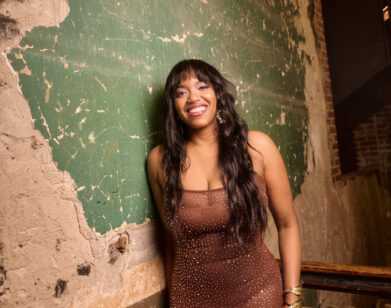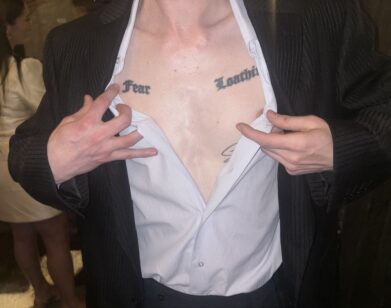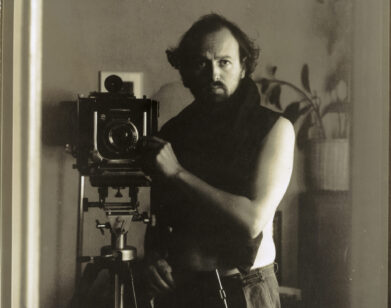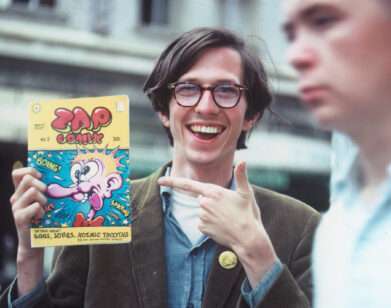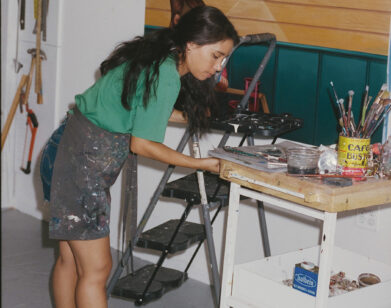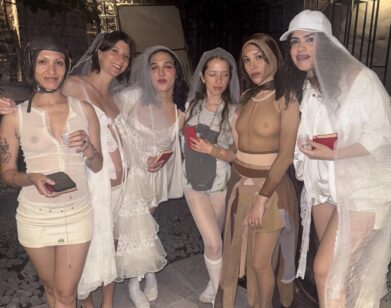David Alexander Flinn
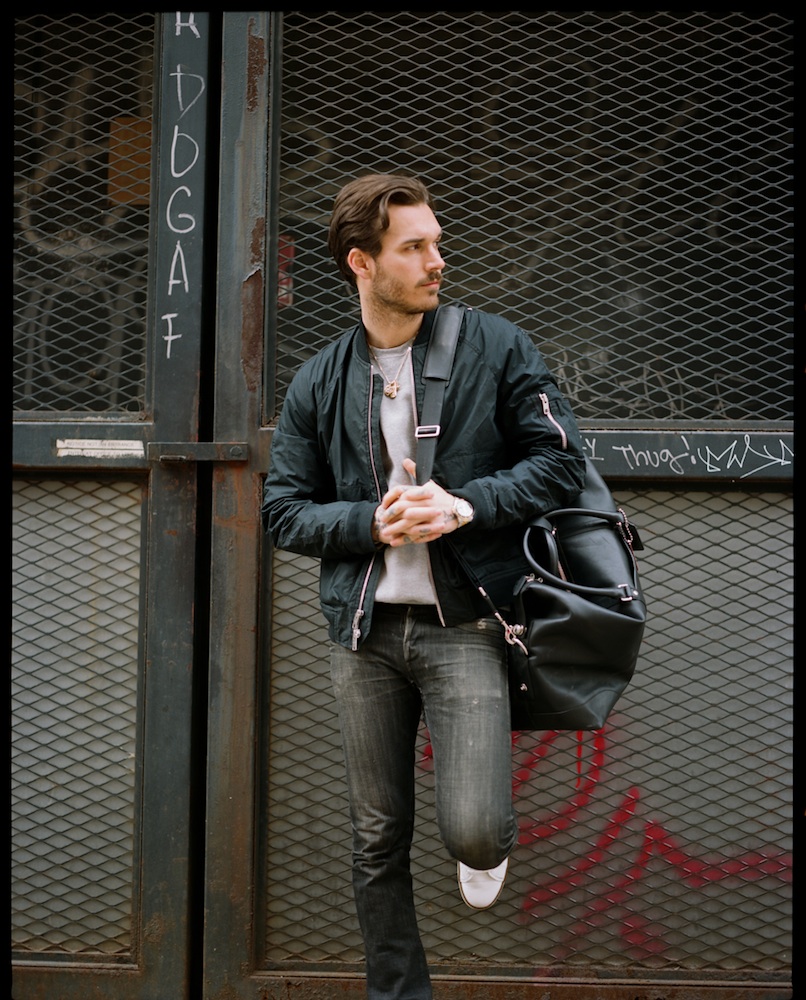
ABOVE: DAVID ALEXANDER FLINN IN NEW YORK, MARCH 2015. PHOTO BY TEDDY FITZHUGH. WAXED NYLON AVIATOR JACKET: COACH. EXPLORER BAG IN PEBBLE LEATHER: COACH.
At the ripe age of 28, David Alexander Flinn is ready to leave New York. The sculptor, filmmaker, and occasional model is considering investing in a property in Pennsylvania and has his eye on an 18-hand Clydesdale horse named Budweiser. “There’s something so powerful in riding them; you just hear them miles away in the forest galloping. They’re such tranquil beings,” he explains.
Growing up between SoHo, New York, and Turin, Italy, Flinn has witnessed the gentrification of Manhattan first-hand. He’s heard the mythology of the Meatpacking District circa the Ballroom scene, and the East Village when it was still home to poets and addicts. His agent has told him stories of when he used to stand by the door at the Mudd Club before it closed in 1983. “Mars Bar, where I had my first drink, is now a weird glass condo,” says Flinn. “They cleaned up the city, but the quality of life and intellectual life aren’t exactly too correlated.”
But Flinn has plenty to keep him busy before he skips town. At the end of October, his new solo show, “Midnight, Everything is Alright,” will open at Envoy Enterprises. He’s still planning his first feature film with model Jamie Bochert, and, of course, there is always modeling. Flinn has frequently collaborated with Steven Meisel, starring in editorials shot by the famous photographer for the likes of Vogue Italia, and in campaigns for high fashion brands such as Coach. In the photograph above, Flinn wears a waxed nylon aviator jacket and carries an “Explorer” bag while walking in his native New York streets. Both items come from Stuart Vevers’ 1970s Americana sportswear-inspired Spring/Summer 2015 collection for Coach—a perfect fit for what Flinn has referred to as his “urban cowboy” aesthetic.
EMMA BROWN: Tell me about growing up between New York and Italy. When did you move?
DAVID ALEXANDER FLINN: My mom is Italian, so I was born in New York and then as soon as I could fly I went back-and-forth. I did six months here and six months there until high school. Then I settled over here and went to college at the School of Visual Arts.
BROWN: Do you come from an artistic family?
FLINN: No, actually, my whole family is professors of economics. My sister is a designer and I’m a sculptor, so interesting products.
BROWN: How do your parents feel about that?
FLINN: My dad studied the labor market, so he was actually kind of happy that we chose such singular and un-mechanically replaceable jobs. In his studies, any kind of professional training will be, at some point, substituted or replaced and it’s good to be a singular product.
BROWN: Do you remember when you realized that you had talent for art?
FLINN: Yeah. I was doing a lot of graffiti in high school; I wasn’t much of an academic child. I got into a bunch of trouble doing graffiti, but I got a lot of praise from the community that I was hanging around with. One day I was walking in the hallway of my high school, which is a small, liberal arts high school, and every night I’d go and do graffiti and I’d make it to school with paint under my fingernails and all over my clothes. I had this amazing teacher named Ms. Wong. She stopped me in the hallway and I had my black book with me, and she asked to look at my black book. She was like, “This is great stuff, would you consider joining my honors art program?” I’d been kind of lost, so I’m glad she helped me figure out my way. Once I was done with high school, my dad said, “You don’t have to go to college if you don’t want to.” I found that quite big of him, being an academic, and so I said I’d apply to one art school. They accepted me on the spot and I guess it was meant to be.
BROWN: What kind of graffiti did you do? Was it images or words?
FLINN: Tags. Just normal graffiti—not street art.
BROWN: What was your tag?
FLINN: It was “YONT,” it started off as “YNOT,” but then I found out there was a guy in Miami that was “YNOT” and he was quite good, so I decided to switch it out.
BROWN: When did you move to sculpture?
FLINN: In my senior year of high school in my honors class, a couple of months in, we started getting a range of assignments that weren’t, “Draw the model!” I immediately started applying textured objects and dimensions to paintings, and so the form has always interested me. As I grew up, I always enjoyed fixing old engines and motorcycles and cars—anything that had some sort of problem-solving. There’s something to shapes and how they interlock and how they fit that has always really stimulated my brain. When I got to SVA, within six months, I was already full-on a part of the sculpture department, which was very separate from the painting and the drawing department. I always identified myself as a sculptor.
BROWN: Do you remember the last piece of art that moved you to tears?
FLINN: I was just at The Met, and they had an incredible Miró painting The Circus Horse. It’s just this blue painting with this incredible horse on it, which is loosely drawn and it has all these amazing dimensions to it but it’s still so static. I love his work.
BROWN: Would you ever move out of New York?
FLINN: Yes, as soon as I can. I’ve paid my dues here. I love the city but it’s changed so dramatically from when I grew up here. I ride horses, and so I’d really like to have a place where I can have a lot of animals and horses and ride horses and my dirt bike.
BROWN: Where did you learn how to ride?
FLINN: We have a family farm in Italy and 20 minutes from there there’s an equestrian center. Then we used to drive up to Vermont and go on vacation up there where there’s a lot of equestrian centers. And my best friend from Pennsylvania,
Foster Zeh, has 14 horses, so I try to go out there once or twice a month. He’s formally trained to train Mustangs—saddling them from the wild. It’s been a really cool experience watching him grow. We’ve known each other 15 years. We worked together at a shop downtown—it’s how I paid for college—doing construction and working in a store. He was a kid from Staten Island. He’s 10 years older than me, but the second we met we were like, “You are me, and I am you.”
BROWN: Are you still working on your feature film?
FLINN: Yeah, I’m still hunting for money. I think that’s every director’s curse, but in the meantime I’ve started on some other projects. Jamie [Bochert] and I, we still talk about it very often and it gives me more time to clean up the script. I feel like I got ahead of myself and hyped that too soon before I knew that the money was locked in and it was more of an empty promise from someone. I’ll keep enigmatic and wait ’til it comes down and people can see what’s going on.
BROWN: I know that you’re quite selective about what you do in terms of being a model. What makes you take a job?
FLINN: If there’s content behind it, for me it’s super important. I think reflecting who I am through a job is more important to me than making another couple bucks…it depends how much those bucks are—I have a price too. But if it’s not a money job that helps me fund projects of mine, then it definitely has to have kind of a story behind it. Probably the person I never question is Steven Meisel. I love working with him just because every shoot is a learning experience for me as a director and a photographer. And also the teams are important. I love working with Karl [Templer], he’s a very intelligent, cultured man. Since I work alone in my studio all the time, I like interacting with people who genuinely have intellectual love for their profession, and passion.
BROWN: Is your sister older or younger?
FLINN: My sister is older. She’s definitely inspired me. We’re very close.
BROWN: Did she ever play mean tricks on you when you were little—tell you outrageous stories that you believed?
FLINN: Oh no, she just dressed me in my mom’s clothes and put makeup on me all the time, which was good because I’m very confident. If someone brings out a dress on a shoot, I’m like, “Been there; you’re not shocking me.” [laughs] She was a good sis.
For more from this series, click here.

